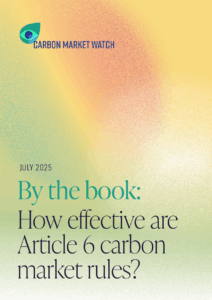In our latest report, we assessed the strengths and weaknesses of the finalised Article 6 rulebook and found so many holes, it’s like a sieve.

At the COP29 climate conference in Baku, countries concluded nine years of negotiations and finalised the rulebook for United Nations carbon markets under Article 6 of the Paris Agreement. Since then, dozens of carbon credit trade agreements have been formalised (with many more in the works), marking the start of Article 6’s implementation phase.
At its core, Article 6 was designed to enhance climate ambition by facilitating voluntary trading of carbon credits between countries. In theory, such cooperation is meant to result in greater emissions reductions than countries can achieve independently. However, in practice it’s likely to be a very different story.
Take, for example, the recent European Union 2040 climate target announcement that outsources a share of its climate action through Article 6 credits rather than outlining how the rich bloc will take responsibility for its own domestic emissions reductions.
Four integral pillars
CMW’s latest report evaluates whether the agreed Article 6 rules are strong enough to generate high-quality carbon credits and allow for increased climate ambition. Unfortunately, our research shows that the rules are far too weak for that to happen.
We measured the strength and integrity of rules against four key and interrelated criteria: carbon credit quality, transparency, accountability, and equity. Each category is an essential pillar in ensuring a credible Article 6 framework – if even one of them is not guaranteed by the rules, the integrity of the entire system remains at risk.
Shaky foundations
After years of negotiations, two distinct carbon market frameworks were defined under Article 6. Article 6.2 defines how countries under the Paris Agreement can use carbon credits toward their climate targets and report on these trades to the UN. Article 6.4 is a UN-supervised carbon market that will directly generate carbon credits available for both countries and others to buy, such as companies and even individuals. The assessment evaluates these two frameworks separately, finding flaws and room for substantial improvement.
The Article 6.2 rulebook sets out a very loose framework, scoring poorly across most of the four evaluation criteria. With no binding requirements for credit quality and significant flexibility in the framework, there is a high risk of poor-quality carbon credits being streamlined through the system to achieve relevant national climate targets under the Paris Agreement (NDCs), obligations under the Carbon Offsetting and Reduction Scheme for International Aviation (CORSIA), and voluntary corporate climate commitments. Current rules also fail to guarantee a robust level of transparency, meaning that some countries are not obliged to disclose complete information regarding their carbon credit trades.
No real accountability in Article 6.2
Furthermore, in most cases there is a lack of requirements to ensure that countries comply with the already weak provisions. While there is a UN review team that is meant to check whether countries are in compliance with the rules, it has a limited mandate and lacks real authority. This means that countries may not face meaningful consequences if they ignore the review team’s recommendations.
This also leaves the burden of scrutiny to outside parties, such as NGOs, to informally monitor trades and flag issues with no guarantee that they will have the capacity to carry out this watchdog role or that their reported findings will be used to end malpractice. This is especially concerning given that access to information will be sparse or might be delayed.
Article 6.4 has room for improvement
Article 6.4 scores better overall than Article 6.2 against the evaluation criteria. It establishes stronger rules that are expected to more reliably deliver on carbon credit quality than in the UN Clean Development Mechanism and certain voluntary carbon market standards, for example, when it comes to setting baselines that form the basis for calculating the quantity of carbon credits.
It also has considerably more robust transparency and accountability provisions, mandating that meetings, key documents, and information are made available to the public for viewing and input through consultation. Nevertheless, it still scores poorly on two assessment criteria. Firstly, the permanence – meaning the measurable lifespan – of emissions reductions and carbon removals is not guaranteed. Secondly, critical loopholes persist across the rules framework leading to doubts about the scheme’s equity, particularly in protecting land rights where carbon market projects take place and whether fair access to grievance mechanisms can be ensured.
Given that carbon markets have a long history of not delivering on their promises, even when the Article 6.4 rules represent an improvement compared to the UN’s flawed Clean Development Mechanism or to most voluntary carbon market standards, this may only represent a marginal and overdue step forward.
What now?
It is critical that the gaps and loopholes identified in the assessment are eliminated and resolved in the future.
For Article 6.2, these revisions must occur when the Article 6 rulebook is up for official review in 2028, which is the next time Article 6.2 rules will be negotiated. For Article 6.4, these revisions can already take place, given that the Article 6.4 Supervisory Body can continually make changes to its rules.
As a rule, and especially until the loopholes are closed, developed countries must first and foremost prioritise domestic emission reductions without using Article 6 as a means to achieve their climate targets on paper. This is necessary not only because developed countries bear significant responsibility for historical and ongoing emissions that require domestic action first, but also in light of how poorly Article 6 carbon markets score in this assessment.
Author
-

Federica Dossi is a global carbon markets expert whose main focus is Article 6 of the Paris Agreement.
View all posts






